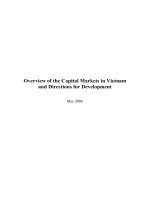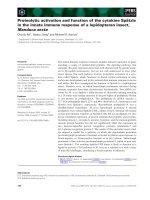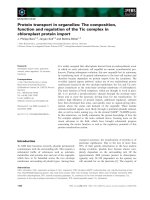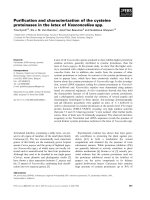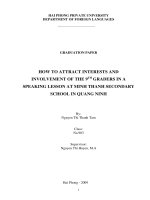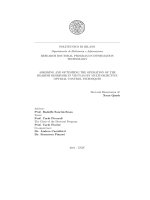Antecedents and outcomes of emotional labor a study of front line employees of the tourism industry in vietnam
Bạn đang xem bản rút gọn của tài liệu. Xem và tải ngay bản đầy đủ của tài liệu tại đây (1.13 MB, 61 trang )
UNIVERSITY OF ECONOMICS HO CHI MINH CITY
International School of Business
------------------------------
Nguyen Anh Phuc
ANTECEDENTS AND OUTCOMES
OF EMOTIONAL LABOR: A STUDY
OF FRONT-LINE EMPLOYEES OF
THE TOURISM INDUSTRY IN
VIETNAM
MASTER OF BUSINESS ADMINISTRATION
Ho Chi Minh City – Year 2018
UNIVERSITY OF ECONOMICS HO CHI MINH CITY
International School of Business
------------------------------
Nguyen Anh Phuc
ANTECEDENTS AND OUTCOMES
OF EMOTIONAL LABOR: A STUDY
OF FRONT-LINE EMPLOYEES OF
THE TOURISM INDUSTRY IN
VIETNAM
MASTER OF BUSINESS ADMINISTRATION
SUPERVISOR: Nguyen Thi Mai Trang
Ho Chi Minh City – Year 2018
ACKNOWLEDGEMENT
Firstly, I would like to say thank you very much to Assoc. Prof. Nguyen Thi Mai Trang (my
supervisor) for her valuable instructions and kind supports in helping me finish this academic
research. I also appreciate the members of the thesis defense committee’s comments and
meaningful suggestions to help me to complete this thesis. My sincere thanks are given to all of
my professors at International Business School – University of Economics of Ho Chi Minh
City for their teaching during my master course. Finally, I would like to express my deepest
thanks for my family, friends for always being my side during studying the master course.
CONTENTS
ACKNOWLEDGEMENT
ABSTRACT
ABBREVIATION
1. Introduction .................................................................................................................. 1
2. Theoretical background and hypotheses ................................................................... 5
2.1 Emotional labor .............................................................................................................. 5
2.2 The relationships among emotional labor and its antecedents and its outcomes .......... 6
2.2.1. The relationship between emotional intelligence and emotional labor ..................... 6
2.2.3. The relationship between job autonomy and emotional labor .................................. 8
2.2.4. The relationship between emotional display rules and emotional labor ................... 8
2.2.5. The relationship between emotional labor and job burnout ...................................... 9
2.2.6. The relationship between emotional labor and job satisfaction .............................. 10
2.2.7. The relationship between job burnout and job satisfaction ..................................... 10
2.3 Research model ............................................................................................................ 11
3. Method ........................................................................................................................ 12
3.1 Procedure and sample .................................................................................................. 12
3.2 Measurement (see Appendix D) .................................................................................. 13
4. Results and discussion ............................................................................................... 16
4.1 Respondents Characteristics ........................................................................................ 16
4.2 Scale validation............................................................................................................ 18
4.3 Results of structural equation modeling analysis (SEM) ............................................ 21
4.4 Discussion .................................................................................................................... 21
5. Conclusion and managerial implications ................................................................. 25
5.1 Conclusion ................................................................................................................... 25
5.2 Managerial implications .............................................................................................. 26
5.3 Limitations and future research ................................................................................... 29
References......................................................................................................................... 30
APPENDICES.................................................................................................................. 35
LIST OF FIGURES
Figure 1. Research model………………………………………………………………. 10
Figure 2. Standardized coefficient path ………………………………………………... 24
LIST OF TABLES
Table 1. Respondents’ characteristics .............................................................................. 17
Table 2. Means, standard deviations, and standardized CFA loadings of items ........ 19, 20
Table 3. Correlations (final measurement model) ............................................................ 20
Table 4. Unstandardized structural paths ......................................................................... 21
ABBREVIATION
CFA
Confirmatory Factor Analysis
EFA
Exploratory Factor Analysis
EFL
English as Foreign Language
HRM
Human Resource Management
CR
Composite reliability
AVE
Averaged variance extracted
SEM
Structural equation modeling
SPSS
Statistical Package for the Social Sciences
ABSTRACT
The new trend of successful tourism companies is truly engaging their front-line service
employees by applying emotional labor theory to maximize service quality, satisfaction,
and behavioral outcomes. This study investigates the antecedents of front-line service
employee emotional labor in the tourism organizations in Vietnam. It also examines the
role of emotional labor toward employee job burnout and job satisfaction. Employing the
CFA & SEM analyses with a sample of 302 front-line employees, the research findings
reveal that emotional intelligence, job autonomy, and emotional display rules has the
positive relationships with emotional labor and emotional labor has a positive
relationship with job burnout. Furthermore, emotional labor negatively relates to job
satisfaction of Vietnamese employees. Finally, job burnout has a negative relationship
with job satisfaction.
Key words: Emotional intelligence, job autonomy, emotional display rules, emotional
labor, job burnout, job satisfaction, tourism.
1. Introduction
The service sector in Viet Nam is identified as one of the key industry to develop the
overall economy growth rate. In the trend of transitioning to the freedom economy, the
service sector, consisting of tourism industry in Vietnam, has always played an important
role. The World Travel & Tourism Council (2014) mentions that the contribution factors
of Travel & Tourism sectors to GDP will be hotels, airlines, airports, travel agents and
leisure and recreation services that deal directly with tourists. The total contribution of
Travel & Tourism to GDP of Vietnam was VND311, 117 Billion (9.6% of GDP) in 2013
and directly created 1,899,000 jobs (3.7% of total employment). Vietnam is one of the
most popular destinations in Asia, the number of international visitors to Vietnam has
been rising every year. It means that tourism industry will have to focus more on better
human resources policies so that they can fare well in the competition and satisfy their
customers due to its special feature is an interaction between service providing by the
service employees and service accepting by customers.
Travel agencies (both traditional and online) dominate the market for Vietnam,
Thailand and the Philippines with a 62%, 66% and 52% share, respectively. However,
direct booking is still getting to the most popular booking channel in Vietnam and
accounts for significant sales in this country (Thornton, 2016). Therefore, creating the
organizations’ reputation is crucial to take advantages the new trend of direct booking
channel. The main characteristic of a service sector is “the contact and interaction
between service providers (employees) and service acceptors (customers)” (Tsaur, Chang
& Wu, 2003, p. 435). The main products provided by tourism organizations are services
1
and the employees who play role as service providers will provide those services to
customers. Thus, employee in the tourism industry becomes a part of service products
and their excellent performance help to form image of organizations (Kusluvan, 2003).
Vietnam tourism industry needs to overcome these issues to optimize its potential at least
by using “professional smiling front-line service workers” to be as “country
ambassadors”.
Today, the new trend of successful tourism companies is truly engaging their
front-line service employees by applying emotional labor theory to enhance satisfaction
with their external customers. As stated by Grandey (2000), interest in emotional labor
for research has been gradually started basing on the work of Hochschild (as cited in
Grandey, 2000). Nowadays, business in the tourism is very competitive so that travel
agencies must focus more on "service with a smile" to improve their reputations basing
on customer satisfaction, employee behavioral outcomes. As mentioned above, front-line
service worker’s performance is one of the key points to obtain customer service using
and royalty. Service workers are therefore requested to regulate their feelings well in
acting when interacting with customers (Karatepe, 2010). Hochschild (1983) uses the
definition of emotional labor to indicate front-line service worker’s actions of trying to
regulate both inside feelings and external appearance of showing these feelings to satisfy
company’s expected emotions. This researcher mentions that emotional labor may
involve showing, pretending to express or suppressing emotions (e.g. showing smiles and
good humor…) and in each case, managing emotions of front-line service workers will
2
result in more effective workplace interaction. Then, emotions have evolved to help
employees act adaptively to customer behaviors and working situations (Grandey, 2000).
Additionally, emotional intelligence shows that employees are able to recognize
and understand any emotional signal. Based on that ability, front-line service employees
may use suitable ways to manage their feelings and encourage intellectual growth
(Salovey & Mayer, 1990). Therefore, emotional intelligence becomes a critical factors to
make emotional issues easier for service workers to regulate. While front-line service
employees perform their jobs, they always interact to customers face-to-face. So they are
asked to show appropriate manners and control their feelings well (Karatepe, 2010).
Thus, a study of both emotional labor and emotional intelligence for understanding
service employee individual emotional expression to help the service employees keep
smiling faces is really important.
The reality is that front-line service workers in Vietnam are facing to different
kind of stresses. Vietnamnet (2017) reveals that employees have to deal with a lot of
unexpected troubles or customers’ bad attitudes leading to work stress and job burnout.
Sexual harassments while contacting with the customers is not an easy case for
employees to handle and these challenges will hurt employees’ emotion (VOV, 2016).
Moreover, these workers admit that they are tired of fixing the frequent bad tourism
environment of destinations in Vietnam or tired of how using their relationships with
intermediaries to perform the best services for customers (Vietnamnet, 2017). Employees
in the service sector also share their anxieties on balancing their times for families and for
working (Tap Chi Du Lich, 2016). Chowdhary and Prakash (2010) show in their study
3
that the above challenges will create mental and physical pressure resulting job burnout,
less job satisfaction and finally low service quality. Up till now, there are a lot of
researches studying about employees’ emotional labor and emotional labor in developed
countries (Hochschild, 1983; Ashforth & Humphrey, 1993; Grandey, 2000) (also see
appendix G). In scholars’ attempts to search for potential antecedents and outcomes that
have high power to explain worker emotional labor in the service industry, Grandey
(2000) conceptualizes a model to help employees to regulate their emotions when
performing their jobs in the workplace which includes situational cues (e.g. interaction
expectations, emotional events), emotion regulation process (emotional labor, individual
factors, organizational factors), results (e.g. individual well-being, organizational wellbeing) and then other works restrict themselves to identify these factors separately or not
in the tourism industry. There is few studies mention the relationships of these factors in
one model to have an empirical research in tourism industry. As the researcher well
searched from previous studies, the study of Hoang (2010) studies the application of
emotional labor to distinguish the differences in emotional labor illustration of female
employees in the low-end sectors and high-end sectors. Very few scholars do the research
about this issue in the tourism industry in Vietnam – where front-line tourism workers
might be counterfeit in claiming for himself or herself by the line others assume he or she
has taken during a particular contact in the contrast of his or her ability to manage
emotions due to a saving face culture in working environment, not basing on
organizational displays rules (Nguyen, Ladkin & Osman, 2016; Quang, Khuong & Le,
2015). More importantly, due to this saving face culture, Vietnamese tourism front-line
4
employees often try to control their manners while face-to-face interact with customers
for long time. They will easily hurt physically or emotionally by stress. Thus, this study
try to understand and fill in this gap by testing the effects of emotional intelligence, job
autonomy, emotional display rules on emotional labor, and subsequently on job burnout
and job satisfaction of front-line service workers who are working in the tourism industry
in Vietnam. Basing on the research results, this finding provides managers a deep
understanding about emotional labor. Therefore, findings of this study can be used to
develop the suitable human capital management strategies in the tourism organizations.
2. Theoretical background and hypotheses
2.1 Emotional labor
Emotional labor refers to “the regulation and expression of organizationally desired
emotions at work in order to fulfill the emotional display requirement of the
organizations or job” (Diefendorff, Richard, & Croyle, 2006; p.17). The research of
emotional labor shows that when front-line service employees are asked to have
particular expressions to customers during working might create more pressures to
employees’ feelings. Grandey (2000) mentions employees experience the process of
regulating their manners and showing up to follow the emotional expectations of a job
(e.g. services). These service workers are expected to regulate their emotions (e.g.
displaying positive emotions and acting friendly) while working with customers,
colleagues and supervisors. This study is going to discover the ways that service workers
control their emotions to satisfy with their works and to improve work outcomes.
5
Diefendorff et al. (2006) and Grandy (2000) study emotional labor by analyzing
how to show (e.g. surface acting) and control feelings (e.g. deep acting) for meeting
organizational goals. Then, the front-line service employees surely know how to interact
with the customers with an enthusiastic and friendly attitude. That is why, more learning
about this concept is really essential for Vietnamese tourism organizations.
2.2 The relationships among emotional labor and its antecedents and its outcomes
2.2.1. The relationship between emotional intelligence and emotional labor
Emotional intelligence is identified as the concept of “social intelligence” to refer the
ability to use emotions in both oneself and others to produce beneficial outcomes (Wong
& Law, 2002; Salovey & Mayer, 1990). Emotional intelligence shows that employees are
able to recognize and understand any emotional signal. Based on that ability, front-line
service employees may use suitable ways to manage their feelings and encourage
intellectual growth (Wong & Law, 2002; Salovey & Mayer, 1990). It is known as “the
ability to recognize and use information in social interactions” (Grandey, 2000, p. 106).
Characterized by considerable face-to-face interaction with customers, the tourism
industry requires front-line employees to manage, regulate, and control their emotions
effectively (Karatepe, 2010). Front-line service workers, who have knowledge and
understand more about emotional intelligence, are more skillful in using suitable behavior
for each social interactions (Balogun, Balogun, & Agesin, 2016). Emotional intelligence
should be more employed by front-line service employees to provide excellent services
for the customers (Grandey, 2000). Based on that, front-line service employees would
6
really know how they feel and why. Then, they are able to regulate their suitable
emotions as requested.
Employees understand the ways to control their own emotions and are able to
manage when being requested which is defined as emotional intelligence. Then,
employees’ abilities to recognize their own emotions and others known as emotional
intelligence will distinguish from their abilities to regulate their own emotions known as
emotional labor. Emotional intelligence is an important factor in changing emotional
behaviors and it modify employee’s emotional labor (Lee & Ok, 2012). Numerous recent
studies has also used emotional intelligence as service workers’ ability for controlling
emotion and their capacity to regulate the feelings knowing as emotional labor (e.g.
Mastracci, Newman & Guy, 2010; Lee & Ok, 2012). Mastracci el al. (2010) reveal the
knowledge or understanding of employees about emotional intelligence as their abilities
that are needed to regulate emotional labor. Additionally, emotional labor will have an
effect on whether a person engages in surface acting or performs deep acting in case they
experience emotional dissonance (Grandey, 2000). As such, these abilities of emotional
intelligence may help front-line workers know when to perform emotional labor.
Emotional intelligence and emotional labor are always together. If there is no existence of
one of them, other will be disappearing (Guy, Newman & Mastracci, 2014). Thus, it is
proposed:
H1: Emotional intelligence will positively relate to emotional labor.
7
2.2.3. The relationship between job autonomy and emotional labor
Job autonomy is defined by Breaugh (1999), a feeling of having freedom or power to
perform the works oneself. It allows employees to experience their abilities to make their
own decisions and to perform a task without control of anyone else. Job autonomy shows
front-line service employees’ willingness to take part in working with freely expressing
company’s expected emotions (i.e. engage in emotional labor). A front-line service
employee (e.g. tour guide in the tourism industry…) usually interacts directly to
customers, so more job autonomy leads more individual choice and discretion involved in
a job and customers satisfaction. In all the situations or circumstances, when front-line
service employees are required to regulate their emotions by the travel agencies with
freedom or without freedom, they are not themselves anymore. Thus, it is hypothesized:
H2: Job autonomy will positively relate to emotional labor.
2.2.4. The relationship between emotional display rules and emotional labor
Display rules are a social group's informal norms about when, where, and how one
should express emotions (Heuven, Bakker, Schaufeli, & Huisman, 2006; Safdar,
Friedlmeier, Matsumoto, Yoo, Kwantes, Kakai, & Shigemasu, 2009). They may be
known as the standard behavior requirement in socializing with other people. Safdar et al.
(2009) state that the way to show feelings may be different and from these points to
identify one's cultural and social identity. Display rules require people to show suitable
attitudes in different circumstances. While emotional intelligence and emotional labor are
employee’s internal abilities to recognize the feelings and manage one’s own emotions,
emotional display rules are external requirements of the organizations asking their people
8
to show feelings. The local cultures are surely different with the others. Additionally, the
Vietnamese front-line service employee (e.g. tour guide…) lacks working experience
with multi-national customers. Thus, the organizations generally use the display rules as
the expectations for emotional expression that the employees should show the public
(Grandey, 2000). Thus, it is proposed:
H3: Emotional display rules will positively relate to emotional labor.
2.2.5. The relationship between emotional labor and job burnout
Burnout is a stress outcome typically found in employees in service industries. Burnout
occurs when an employee becomes overly emotionally involved in interactions with
customers and has little way to replenish those emotional resources being spent
(Schaufeli & Enzmann, 1998; Grandey, 2000). The signs of burnout are emotional
exhaustion, depersonalization, and reduced personal accomplishment (Cordes &
Dougherty, 1993). When front-line service workers (e.g. tour guide…) are usually face to
face to customers and in this situation they have to know ways to regulate their emotions.
By repeating these actions every day, service workers may be aware of losing emotional
feeling or tiredness. To deal with this happening problems in emotions, front-line service
workers separate themselves from customers by opposing or lying them. If these
problems are not solved, employees will have bad feelings about themselves, their jobs,
and their job performance might reduce as long consequences (Cordes & Dougherty,
1993). Thus, it is hypothesized:
H4: Emotional labor will positively relate to job burnout.
9
2.2.6. The relationship between emotional labor and job satisfaction
Job satisfaction is a positive feeling of love doing job and it is also a way to help
employees to evaluate their job performance (Dubinsky & Hartley, 1986). It is said that
when front-line service workers are requested to be nice to customers may help them
enjoy doing their works (Ashforth & Humphrey, 1993). Nevertheless, trying to regulate
their emotions for too while service workers have internal emotional conflicts may
threaten personal feeling (Hochschild, 1983). Vietnam is a keeping face culture,
Vietnamese tourism front-line employees are (e.g. tour guide…) usually face to face to
customers and in this situation they have to know ways to regulate their emotions. By
repeating these actions every day, service workers may be aware of losing emotional
feeling or tiredness and lower their satisfactions. It means the service workers who often
try to regulate emotions with customers may have less job satisfaction. Thus, it is
proposed:
H5: Emotional labor will negatively relate to job satisfaction.
2.2.7. The relationship between job burnout and job satisfaction
According to the work of Rothmann (2008), a positive feeling of love doing job will be
affected very much by too much stress while working. Fairbrother and Warn (2003) state
that employees have more job burnout will reduce their pleasant of performing their jobs.
Furthermore, Rothmann (2008) reaffirms that job satisfaction has been negatively
impacted by pressure or worry caused by the problems on jobs. It shows that when
pressure of work increases and love of doing job will decrease. It is a key point of low
job involvement for frontline service workers in the tourism industry. Additionally, as it
10
is mentioned above, Vietnamese tourism front-line employees often contact face-to-face
to customers with stress will lower their satisfactions. Therefore, the researcher proposed
a hypothesis:
H6: Job burnout will negatively relate to job satisfaction.
2.3 Research model
Figure 1: Research model
11
3. Method
3.1 Procedure and sample
This study were undertaken by an in-depth question qualitative study and a questionnaire
survey from employees in Ho Chi Minh City since most of travel agencies centralize here
(69.7% of Vietnam) & the travel agency creates a link between the customers and service
suppliers (Department of tourism Ho Chi Minh City, 2017). Respondents were front-line
employees (e.g. tour guides…) who are working in the tourism industry. The original
scales was used in the in-depth interviews to adjust the items being suitable for
Vietnamese respondents. The main quantitative survey was used to test the measurement
and structural models. Through the qualitative study, the questionnaires, which were
translated into Vietnamese, were used to question six people in order to modify and
revise all observed items of the draft questionnaire to make improvement for the official
questionnaire. From June 7th to June 14th, there were six interviews conducted in Ho Chi
Minh City. Each question of the measurement scale was alternatively asked for
respondents’ understanding and suggestions until every item being fully understood. The
final measurement scales was slightly modified to be suitable used in Vietnam (see
Appendix A, B, & C).
The method of self-administered survey with the convenience sampling approach
was employed for this study. The measurement scales in this study had forty one items so
that the minimum sample size should be: n=41*5=205 samples. From July 13th to
September 25th, electronic mail (emails of respondents were provided by tour operators
and by Saigon tour guide union), Google survey (to Saigon tour guide union) and hard
12
copies were (to travel agency offices) used to deliver 500 questionnaires to participants
who are working as front-line officers for travel agencies in Ho Chi Minh City (via
electronic mail was 21%, Google survey was 58% and hard copies were 21%).
After data collection, the researcher collected total 356 responses from 35 travel
agencies; the answer rate was 71.2 percent. Then, total 54 answer sheets were not used
because they were not suitable (13 answers were not from the tourism industry; 8 answer
sheets with the same answer for all questions; and the others with missing answer
values). Finally, 302 answers were enough to be analyzed comparing with a necessary
sample size. The data was used to be calculating Cronbach’s alpha, CFA to test the
reliability and validity of each measurement scale. Then, the model and hypotheses were
tested by using SEM analysis.
3.2 Measurement (see Appendix D)
Job autonomy
Job autonomy was measured by seven-item scale (adapted from Breaugh, 1999).
Job autonomy (adapted from Breaugh, 1999)
JobAuto1. I have freedom choose the ways to do my job
JobAuto2. I can manage my work timetable
JobAuto3. I can arrange my work activities (when I do).
JobAuto4. It is possible for me to decide when to do specific work activities.
JobAuto5. My job allows me change how to be evaluated so that I can highlight my job and
play down others.
JobAuto6. I am allowed to change my job objectives
JobAuto7. I am allowed to manage what I am asked to achieve by my supervisor.
13
Emotional intelligence
Measurement scales for the four components of emotional intelligence comprised of four
components: self-emotions appraisal (3 items); others-emotions appraisal (3 items); use
of emotion (3 items); regulation of emotion (3 items) (adapted from Wong & Law, 2002).
Emotional intelligence (adapted from Wong & Law, 2002)
Self-emotions appraisal
SelfEmoA1. I can often know why I have certain feelings.
SelfEmoA2. I understand my own emotions very well.
SelfEmoA3. I always know whether or not I am happy.
Others-emotions appraisal
OtherEmoA1. I know my friends’ feelings from their external manners all the time.
OtherEmoA2. I am a very good person who can see others’ emotions.
OtherEmoA3. I can recognize emotions of people surrounding me.
Use of emotion
UseEmo1. I always have objectives and have big efforts to get them.
UseEmo2. I always trust my competences.
UseEmo3. I encourage myself for being well.
Regulation of emotion
RegulaE1. I can regulate my manner so that I can control difficulties critically.
RegulaE2. I calm down quickly when I lose my temper.
RegulaE3. I regulate my own emotions very well.
Emotional labor
Emotional labor was measured by two sub-dimensions: Deep acting: 4 items; Surface
acting: 4 items (adapted from Diefendorff et al., 2006).
14
Emotional labor (adapted from Diefendorff et al., 2006)
Deep acting
DeepAct1. I just want to do my job without being annoyed.
DeepAct2. I try to recognize the emotions that I need to show to others
DeepAct3. I try my best to feel the emotions that I need to show to customers
DeepAct4. I try to develop my internal feelings that I need to show to my clients
Surface acting
SurfaceAct1. I give an appropriate action to deal with customers
SurfaceAct2. I just pretend to have the emotions I need to display for my job
SurfaceAct3. I express my emotions to client that are different from what I feel inside
SurfaceAct4. I fake a good mood when interacting with customers
Emotional display rules
The measurement scale of emotional display rules was used by four-item scale (adapted
from Heuven et al., 2006).
Emotional display rules (adapted from Heuven et al., 2006)
EmoDisplay1. I am requested to only express positive emotions to customers
EmoDisplay2. I am requested to never express negative emotions to customers
EmoDisplay3. I am requested to place myself in the situation of customers
EmoDisplay4. I am requested to be sincere and authentic with customers interactions
Job burnout
Burnout’s measurement scale was used by five items (adapted from Schaufeli &
Enzmann, 1998).
15
Job burnout (adapted from Schaufeli & Enzmann, 1998)
JobBurn1. I feel less interested in doing my work since I began doing this job
JobBurn2. My work does not sound enthusiastic to me
JobBurn3. I have uncertain feelings about the importance of my job
JobBurn4. I am more skeptical about my contribution
JobBurn5. I am extremely tired from my work
Job satisfaction
Job satisfaction was measured by five items adapted from Lytle (as cited in Kim, Leong
& Lee, 2005)
Job satisfaction (adapted from Lytle (as cited in Kim, Leong & Lee, 2005))
JobSatisf1. I think my job enjoyable
JobSatisf2. I am quite satisfied with my current job
JobSatisf3. I love my work very much
JobSatisf4. My job is very special
JobSatisf5. I really enjoy doing my job
Likert scale of seven-point from 1=strongly disagree to 7=strongly agree was used to
measure the scales. These items were adjusted and refined to be suitable for Vietnamese
cultures. Then, questionnaires were translated into Vietnamese for the main survey (see
Appendix D).
4. Results and discussion
4.1 Respondents Characteristics
The SPSS software was used to analyze data and the findings of the demographic
analysis were described in Table 1.
16
Table 1. Respondents’ characteristics
Demographic profile
Category
Frequency
Percentage (%)
Gender
Male
181
59.9
Female
121
40.1
Total
302
100
19 – 23
56
18.5
24 – 30
190
62.9
31 – 45
54
17.9
Over 45
2
0.7
Total
302
100
Income per month
Less than 6
3
1.0
(million VND)
From 6 to less than 9
17
5.6
From 9 to less than 14
145
48.0
Above 14
137
45.4
Total
302
100
Experience
Less than 0.6
0
0
(years)
From 0.6 to 2
122
40.4
Over 2
180
59.6
Total
302
100
Age group
Initial analysis of data indicated that there were 35 travel agencies in HCM City
with 302 respondents including front-line service officers. Male rate was 59.9% of
respondents and female was 40.1% of the sample. More than 62.9% of the participants in
this study were from 24 to 30 years old and old participants held very small rate with
only 0.7%. Income per month was divided in four groups with 93.4% of sample had high
salary over 9 million VND.
17
4.2 Scale validation
Scales in this research were evaluated by factor loadings indicators, Cronbach’s alpha
indicators, composite reliability (CR) and the average variance extracted (AVE) in
confirmatory factor analysis (CFA) to test the scale reliability, discriminant and
convergent validity. Each first-order construct and second-order construct was evaluated
separately by using CFA methods. CFA results showed that some items needed to be
removed out of research model to fit with market data (see table 2). Running the CFA for
the final measurement model, the author removed EmoDisplay1, JobAuto7 and JobBurn4
because their factor loadings were lower than .5 (.39, .40 and .32 respectively).
Emotional display rules was still measured by 3 observed items: EmoDisplay2,
EmoDisplay3, EmoDisplay4; Job autonomy was measured by six items (JobAuto1,
JobAuto2, JobAuto3, JobAuto4, JobAuto5, and JobAuto6) and job burnout was measured
by JobBurn1, JobBurn2, JobBurn3, and JobBurn5. Thus, the measurement scales of each
dimension were still acceptable. The model fit of running CFA was good with the
minimum discrepancy of 1.889; the probability of getting a discrepancy was .000; the
comparative fit index was .947; The Tucker-Lewis coefficient was .942; the probability
of getting a sample RMSEA as large as .054 is .063. Estimates of standardized regression
weights of all items were higher than 0.5 with p<.001. Additionally, the scales in this
study with average variances extracted indicators over 0.5, composite reliabilities and
cronbach’α higher than 0.76 (see Appendix F & G) showed construct reliability,
convergent validity, and discriminant validity of the measurement scales. (Fornell and
Larcker, 1981; Steenkamp & Van Trijp, 1991).
18
